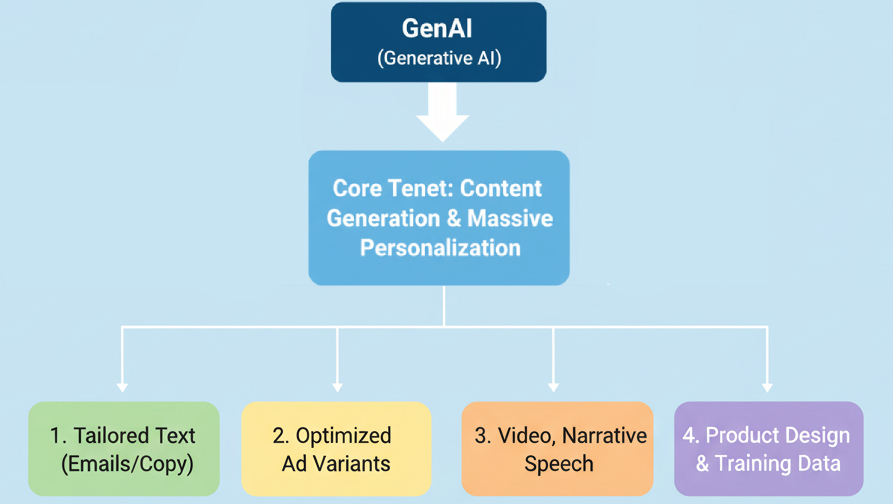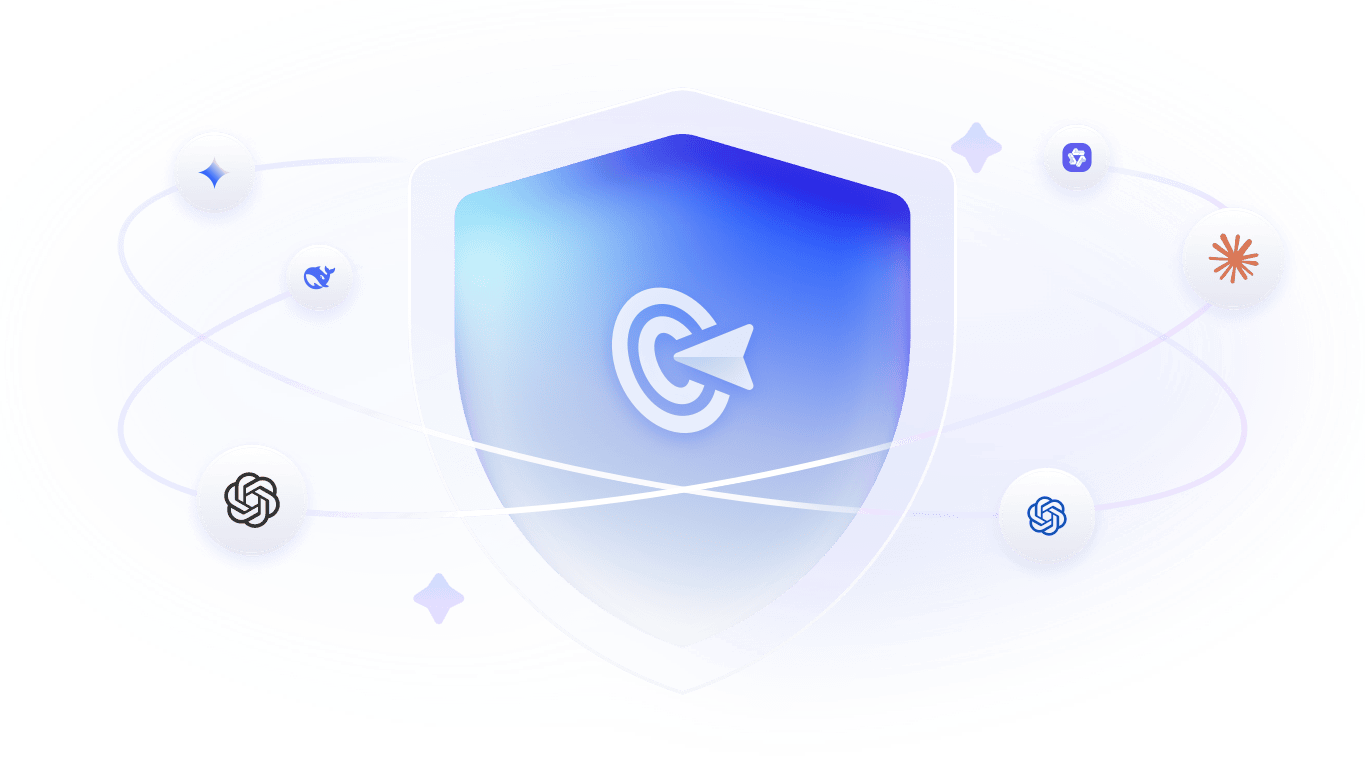- The Three Core Functions of GenAI In Marketing
- 1. Enhance Content and Customer Experience
- 2. Guide Customer Decisions
- 3. Streamline Operations
- How GenAI Re-Architects the Content Production Process
- The Shift of Content Production: From Linear Pipeline to Agile Flywheel
- Deconstructing Agile Flywheel Style Content Production
- A Practical Guideto Getting Started
Generative AI (GenAI) is one of today's most sought-after technologies; a game-changer in creating text, image, and video content at the click of a button. Yet, many still treat it as a standalone productivity tool that simply 'replaces' human tasks.
In actuality, GenAI's transformative power is better used as an engine to redefine the workflow itself, enabling efficient, adaptive, and data-driven content creation.
Today, we're using Gartner's latest report on "AI in Marketing" as a basis for the three core functions of GenAI in marketing, and showing its impact on re-engineering the content production process.
The Three Core Functions of GenAI In Marketing
1 Enhance Content and Customer Experience (CX)
The first core tenet of GenAI in marketing, as identified by Gartner, is content generation and personalization to enhance the customer experience.
GenAI allows teams to produce tailored content at scale, whether it's email templates, product descriptions, marketing copy, ad variations optimized for engagement per channel, and much more.
As highlighted by Gartner's report:
"It (GenAI) produces new content artifacts such as video, narrative, speech, training data and product designs."
But one of the bigger use cases is its flexibility.
Rather than generating within the same category, its strength lies in the ability to "produce entirely unique artifacts or improve existing ones" across modalities, whether it's in the same modality (text to text) or against different modalities (text to image).
This provides marketers a broad range of tools to produce diverse text, visuals, and videos to improve brand perception, enhancing the user experience.

2 Guide Customer Decisions
Beyond creative input, GenAI can play a big role in guiding customer journeys. This happens in multiple facets, but one of the most prominent is with something called "Influence AI".
Gartner mentions that Influence AI is "the use of algorithms to automate digital experience elements and guide user choices at scale". What this translates to is enhancing the overall customer experience by nudging customer decisions subtly.
This optimizes what the customer sees, in what order, and under which context to enhance "choice architecture", subtly encouraging desired actions.

For example, Gartner mentions that healthy & beauty brands implement AI by analyzing skin and hair type to present relevant product choices, displaying personalized product options that simplify decision-making and reduce choice fatigue.
3 Streamline Operations
AI can also transform the way marketing teams operate. Gartner notes that using AI can "reduce friction & eliminate redundancy" in operations by freeing marketers for more integral tasks, such as analytics, insights, and strategy.
This can come in the form of:
- Automating repetitive processes
- Predicting & refining production bottlenecks
- Optimizing content delivery across channels for more valuable, effective campaigns.
Additionally, AI-driven workflows can also help with the strategy process. By utilizing AI to analyze large data sets, enables teams for faster decision-making backed by data.
Gartner sees this as a step towards future-proofing marketing teams, creating "fusion teams with a blend of professionals from each practice, fostering open communication and collaboration".
Combining these three functions clearly illustrates GenAI's role not as a single tool, but as a structural transformation. In the next section, we'll explore how this technology evolves the traditional content production model into a continuous, adaptable loop.
How GenAI Re-Architects the Content Production Process
The Shift of Content Production: From Linear Pipeline to Agile Flywheel
Traditionally, content production follows a set & predictable flow: request → creation → review → publication.
This linear approach works at lower scales, but as demand for personalized, multi-channel material grows, the process is rendered inefficient. Teams deal with delays in approval, time-consuming & repetitive manual edits, and other factors that slowed production.
Generative AI introduces a more dynamic system, a closed-loop flywheel, that continuously learns & improves. The process transforms to a model that follows a cycle of: generate → evaluate → optimize.
This way, the cycle is a continuously self-improving workflow, taking feedback for the next round, incorporating it, and delivering optimized output. This not only accelerates content production and delivery, but maintains & improves quality over time.
Deconstructing Agile Flywheel Style Content Production
1. Generate
The first step of this new workflow is generation; leveraging tools powered by large language models and multimodal AI to produce text, visuals, audio, and video. These contents are generated with user-provided text or "prompts", providing clear instructions on what you want to generate.
While this may seem like taking the "human" out of the equation, human input is still vital in GenAI.
AI output is only as good as the instructions you provide. Only teams that can properly frame instructions/prompts and set tone & brand parameters can generate usable, effective results.
Rather than an autonomous creator, AI should be thought of as a supplemental tool to supercharge teams. Use it to draft variations of a blog post, social copy, or campaign slogans in seconds.
But only human oversight can ensure that the output aligns with:
- Brand expectations
- Campaign goals
- Accuracy
- Originality
2. Assemble & Distribute
Once generated, content components can be combined and distributed across multiple channels.
Instead of manually piecing content together, AI can help modularize assets, breaking them into pieces (visuals, headlines, CTAs, snippers, etc.) to be assembled based on audience, channels, and campaign goals.
For example, AI systems can automatically analyze and push appropriate content to the right platforms:
- A short-form video for social media like TikTok or Instagram Reels
- A visual/graphic for an email banner or newsletter
- Personalized copy to a landing page
This way, the distribution process is based on rules and user data. Instead of manually tailoring content for each channel, GenAI and marketing automation tools handle it dynamically, leaving marketing teams free to handle strategy & storytelling.
3. Evaluate
With the traditional model, evaluation was late and heavily dependent on manual reporting. With new GenAI-driven models, performance evaluations are embedded directly into the process.
With the use of analytic dashboards and AI-assisted insights, teams can track content variation performance across key metrics like:
- Click-through rates
- Engagement
- Dwell time
- Conversions
With ongoing evaluation, marketing teams have a full view into which messages resonate, which visuals convert, and which formats underperform.
4. Optimize
The last step is optimization to close out the loop and restart the cycle. Using AI-generated insights & analytics, teams can adjust the generation process, creative direction, and distribution rules to improve performance.
Based on results, teams can modify prompts to better align with successful content.
For example, if analytics show that AI-generated blog posts with emotion-driven phrasing lead to higher conversion, future content can follow the same pattern.
Over time, this builds a learning system where both human teams & AI learn what works, and get "smarter" through feedback.
It's an experimentation process that'll take trial-and-error, so we'd suggest launching multiple variations rather than one "big" campaign. Launch with slight variations, analyze real-time performance, and refine quickly.
The end result should have faster iteration, better targeting, and a higher ROI.
This transformation is a shift from a static, one-way workflow to a dynamic, adaptive system.
The generation, evaluation, and optimization loop makes content production a self-improving cycle, with every campaign informing the next.
Based on three core functions, the system enhances content and experience via real-time personalization, guides decisions with data-driven insights, and streamlines operations by removing manual work.
Consequently, the process is a smarter, faster, and more agile content engine, improving with every iteration.
A Practical Guide to Getting Started
Principle
While this can seem like a major project, it doesn't have to be.
Instead of a major overhaul of the entire content production system, start small; identify specific areas where AI can deliver quick wins, analyze the results, and gradually expand organization-wide when you figure out what works.
With a phased approach, organizations reduce risks, allow teams to learn, document best practices, and build confidence in AI-assisted workflows.
A Four-Step Implementation Path
Identify Entry Points
Start by identifying and listing out content tasks that can benefit from GenAI. For example, tasks that take up the most time or involve repetitive manual work. Some examples include:
- Writing product descriptions
- Repurposing blog posts
- Drafting ad variations
- Updating metadata across platforms
To simplify the process, ask "which of these tasks could AI handle without compromising quality?".
Select a Pilot Project
Once entry points are identified, select one to run a pilot project. Try to keep it something well-defined and measurable.
The goal here isn't to get things perfect right away; rather, it's to gauge how AI can enhance efficiency and consistency. For example, your team could test AI for generating LinkedIn post variations or email subject line A/B tests.
During the pilot project, experiment with prompts and review prompts manually to find what works best. This teaches teams how to align AI output more closely to brand voice and audience preferences.
Define the Operating Model
Before scaling, clarify how AI fits into the team's workflow. Determine and assign roles to individuals who create prompts, who review & select appropriate AI-generated content, as well as who analyze performance data & optimization.
Establishing these roles early keeps outputs & results consistent and accountable when the project grows.
Standardize and Scale
Lastly, once the pilot delivers consistent & satisfactory results, document every effective process, including:
- Prompt formats
- Review checklists
- Tagging systems
- Data feedback loops
Turn these into standardized playbooks or SOPs for future content requirements. Once there's a solid foundation, GenAI can scale to other workflows and transform isolated use cases into an integrated ecosystem.
From there, AI will be able to enhance every facet of content production to help teams move faster, collaborate better, and maintain quality even with output increases.
Conclusion
Generative AI is more than a content tool; it's the foundation of a smarter, more adaptive workflow.
By enhancing creativity, guiding decisions, and streamlining operations, GenAI transforms how teams plan, produce, and refine content. The goal isn't to chase one perfect AI platform but to rethink and connect every stage of your process.
Integrating solutions like GoInsight.AI's helps teams build automated, data-driven workflows that scale efficiency, boost collaboration, and deliver more personalized results in marketing.
Start Free Trial





Leave a Reply.